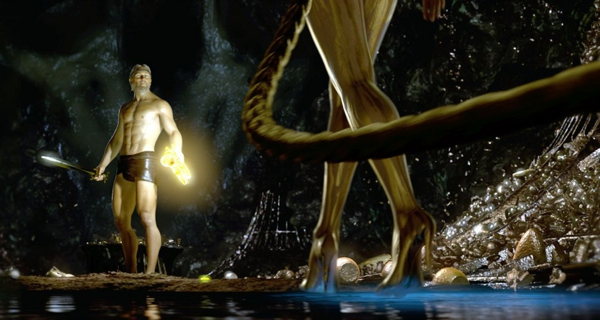Movie review by Greg Carlson
Since the vast majority of its audience will not have read the original, only indignant professor-types, Old English scholars, and epic poetry nerds are likely to take issue with any of the changes brought to the latest interpretation of “Beowulf.” Clearly designed as a Hollywood money-making machine engineered to separate teenage boys from their allowances, Robert Zemeckis’ latest exercise in state-of-the-art motion capture technology reveals a mixed bag of filmmaking suspended somewhere between animation and live-action. On that score, “300,” which is being regularly compared to “Beowulf,” proves the victor, as the weird mannequins of the latter lack life in their glassy, CG eyes.
Zemeckis might be more enamored of the revolutionary filmmaking process than other directors of his rank, or maybe he just smells the money. Either way, the human characters look like they belong in a videogame rather than on the silver screen, a deficit that merely ratchets up the tedium when the movie hits any number of dull patches. Because the digital versions are modeled to mostly look like their human counterparts, audiences cannot help but be put in mind of the flesh and blood actors. While Anthony Hopkins and Angelina Jolie are the most familiar, other renderings produce only off-putting approximations. Both Robin Wright Penn and Alison Lohman are stuck with doppelgangers whose eyes are spaced too close together.
Co-writers Neil Gaiman and Roger Avary labor to make their version of the title persona three-dimensional, and the character flaws they concoct, likely to bridge the half-century time gap between the story’s second and third sections, stretch Beowulf into a deeply flawed braggart whose tendency toward self-mythology strokes his ego beyond the edge of self-delusion. Surprisingly, this seems a solid choice, since it brings a shred of intrigue to the otherwise empty adventure. Beowulf wears hubris well, and the movie could have used even more of Gaiman and Avery’s experimentation.
Who would have imagined that Grendel’s mother looks like Angelina Jolie covered in gold paint? A long way from the monstrous hell bride, hag, or ugly troll lady depicted in different versions of the story, Jolie’s powerful seductress invokes the readings that focus on the awe-inspiring fearsomeness of a truly formidable opponent. Giant-size liberties are taken in the rendering of Beowulf’s showdown with Grendel’s mother, and viewers looking for a knock-down battle will instead be surprised to see a sexually-charged engagement ending with conception in the place of decapitation.
The wild, airborne clash between Beowulf and a fire-breathing dragon that constitutes the movie’s final set-piece makes good use of the attractively configured landscape. Finally delivering on some of Beowulf’s promised derring-do, the sequence compensates for the ridiculousness of the all-nude dustup between the hero and his hideously deformed foe Grendel. In the earlier scene, Zemeckis strategically places objects in front of B.’s genitals in what feels like a twisted homage to a similar device in the Austin Powers movies. Ultimately, no amount of humor, whether intentional or not, can rescue this variant from its wearisome shallowness, and neither can the allure of a digital Jolie au naturel.
